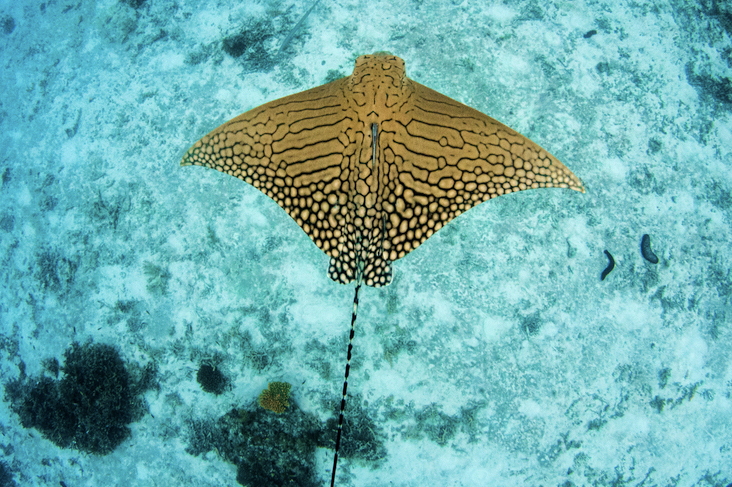Ornate Eagle Ray, Aetomylaeus vespertilio (Bleeker 1852)
Other Names: Ornate Eagleray, Reticulate Eagle Ray

An Ornate Eagle Ray, Aetomylaeus vespertilio, at Lady Elliot island, Grat Barrier Reef, Queensland, February 2018. Source: Jeremy Somerville via lovesfishes1986 / iNaturalist.org. License: CC By Attribution-NonCommercial
Summary:
An eagleray with a complex pattern of lines, reticulations and spots on the upper surface of the disc.
Footage of an Ornate Eagle Ray swimming around "Barracuda Bommie", on the Agincourt reefs, Great Barrier Reef, Queensland.
Footage of an Ornate Eagle Ray swimming around "Barracuda Bommie", on the Agincourt reefs, Great Barrier Reef, Queensland.
Cite this page as:
Bray, D.J. 2020, Aetomylaeus vespertilio in Fishes of Australia, accessed 01 Jul 2025, https://fishesofaustralia.net.au/Home/species/4287
Ornate Eagle Ray, Aetomylaeus vespertilio (Bleeker 1852)
More Info
|
Distribution |
Shark Bay, Western Australia, to Lady Elliot Island, southern Great Barrier Reef, Queensland. Elsewhere the species is widespread with a patchy distribution in the Indo-west Pacific. Inhabits bays, sandy areas and coral reefs at depths to 100 m. This species is rarely observed and may be naturally uncommon. |
|
Biology |
Ovoviparous (aplacental viviparity) - embryos feed initially on yolk, then receive additional nourishment from the mother by indirect absorption of uterine fluid enriched with mucus, fat or protein through specialised structures. |
|
Fisheries |
Taken in commercial fisheries in many parts of its range. |
|
Species Citation |
Myliobatis vespertilio Bleeker 1852, Verhandelingen van het Bataviaasch Genootschap van Kunsten en Wetenschappen 24: 85. Type locality: Jakarta (as Batavia), Java, Indonesia. |
|
Author |
Bray, D.J. 2020 |
|
Resources |
Ornate Eagle Ray, Aetomylaeus vespertilio (Bleeker 1852)
References
Bleeker, P. 1852. Bijdrage tot de kennis der Plagiostomen van den Indischen Archipel. Verhandelingen van het Bataviaasch Genootschap van Kunsten en Wetenschappen 24: 1-92
Compagno, L.J.V. & Last, P.R. 1999. Families Gymnuridae, Myliobatidae, Rhinopteridae, Mobulidae. pp. 1505-1529 in Carpenter, K.E. & Niem, V.H. (eds). The Living Marine Resources of the Western Central Pacific. FAO Species Identification Guide for Fisheries Purposes. Rome : FAO Vol. 3 pp. 1397-2068.
Dulvy, N.K. & Reynolds, J.D. 1997. Evolutionary transitions among egg-laying, live-bearing and maternal inputs in sharks and rays. Proceedings of the Royal Society London, Ser. B: Biol. Sci. 264: 1309-1315.
Fowler, H.W. 1941. Contributions to the biology of the Philippine Archipelago and adjacent regions. The fishes of the groups Elasmobranchii, Holocephali, Isospondyli and Ostariophysi obtained by the United States Bureau of Fisheries Steamer Albatross in 1907 to 1910, chiefly in the Philippine Islands and adjacent seas. Bulletin of the United States National Museum 100(13): 1-879 figs 1-30 (as Aetomylus vespertilio)
Garman, S. 1908. New Plagiostomia and Chismopnea. Bulletin of the Museum of Comparative Zoology, Harvard 51(9): 249-256 (as Aetomylaeus vespertilio)
Garman, S. 1913. The Plagiostomia (sharks, skates and rays). Memoirs of the Museum of Comparative Zoology, Harvard University 36: 1-528 pls 1-77 (as Aetomylaeus vespertilio)
Kyne, P.M., Johnson, J., Courtney, A.J. & Bennett, M.B. 2005. New biogeographic information on Queensland chondrichthyans. Memoirs of the Queensland Museum 50: 321–327
Larson, H.K., Williams, R.S. & Hammer, M.P. 2013. An annotated checklist of the fishes of the Northern Territory, Australia. Zootaxa 3696(1): 1-293
Last, P.R. & Stevens, J.D. 1994. Sharks and Rays of Australia. Canberra : CSIRO Australia 513 pp. 84 pls.
Last, P.R. & Stevens, J.D. 2009. Sharks and Rays of Australia. Collingwood : CSIRO Publishing Australia 2, 550 pp.
Moore, G.I., Morrison, S.M. & Johnson, J.W. 2020. The distribution of shallow marine fishes of the Kimberley, Western Australia, based on a long-term dataset and multiple methods. Records of the Western Australian Museum Supplement 85: 105-115
Randall, J.E. 2005. Reef and shore fishes of the South Pacific. New Caledonia to Tahiti and the Pitcairn Islands. Honolulu : University of Hawaii Press 707 pp.
Russell, B.C. & Houston, W. 1989. Offshore fishes of the Arafura Sea. The Beagle, Records of the Museums and Art Galleries of the Northern Territory 6(1): 69-84
White, W.T. 2014. A revised generic arrangement for the eagle ray family Myliobatidae, with definitions for the valid genera. Zootaxa 3860(2): 149–166
White, W.T. & Kyne, P.M. 2016. Aetomylaeus vespertilio. The IUCN Red List of Threatened Species 2016: e.T60121A68607665. https://dx.doi.org/10.2305/IUCN.UK.2016-1.RLTS.T60121A68607665.en. Downloaded on 20 May 2020.
White, W.T. & Last, P.R. 2016. 30. Eagle Rays. Family Myliobatidae. pp 706-725 in Last, P.R., White, W.T., Carvalho, M.R. de, Séret, B., Stehmann, M.F.W. & Naylor, G.J.P. (eds). Rays of the World. Clayton South, Victoria : CSIRO Publishing 790 pp.
White, W.T., Last, P.R. & Baje, L. 2016. Aetomylaeus caeruleofasciatus, a new species of eagle ray (Myliobatiformes: Myliobatidae) from northern Australia and New Guinea. Ichthyological Research 63(1): 94-109, https://doi.org/10.1007/s10228-015-0480-9
White, W.T. & Potter, I.C. 2004. Habitat partitioning among four elasmobranch species in nearshore, shallow waters of a subtropical embayment in Western Australia. Marine Biology 145 (5): 1023–1032 DOI: 10.1007/s00227-004-1386-7





